We took this picture almost exactly a year ago. We had just come up a seemingly never-ending uphill in baking heat, and were making our first pedal strokes in Portugal. Little did we know at that time that we would cycle well over 2000 kilometres in this country, spread over the whole year. Summer, winter, spring.
It’s about time I write this post!
Note: If you don’t like reading long posts and just want to read the essential stuff, we invite you to read our guest post about the top five reasons to go bicycle touring in Portugal we wrote for the A-Z of bicycle touring project.
We arrive to a village. Nobody in the streets, it seems dead at this time of the afternoon. The air is hot, we’re in mid-September. We circle around a bit, getting lost in one-way streets, lined by white-washed houses, until we reach the central place. There are two cafés, people sitting on the terrace, children playing. We buy two cokes. “The dirty water of capitalism”, as Miguel likes to call it. So be it, but it satisfies our thirst for fresh water, minerals and sugar. A bit later, we fill up our water bottles and cycle on, through olive groves and vineyards. We eat ripe figs directly from the tree. The road is quiet, it feels like the middle of nowhere. It’s perfect and it’s just another day cycling in Portugal.
Table of Contents
Portugal is one of our favourite countries for cycle touring. Admittedly, we are a bit biased. We speak the language (or rather, Miguel does and I try to make sense of it), we understand the culture. We know how to order the right kind of coffee, we understand the menu in the restaurant.
Before venturing on the roads of Portugal by bicycle, we had already explored a big part of the country by other means of transport (car, mostly). But this doesn’t mean that there was nothing new to see. Travelling by bicycle made us discover differently the places we already knew, and see corners where we hadn’t been before. What a blast it was to cycle into Lisbon for the first time, having cycled all the way from Switzerland! The pleasure of arriving in this familiar place by bicycle, where we had always arrived by plane before.
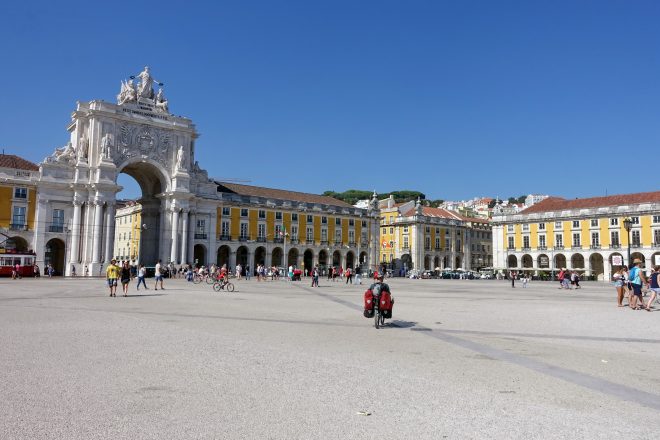
So, here’s how it was:
The route – Best of
For the sake of shortness and readability, we won’t detail the exact route here. We’ll just outline our personal Best of Portugal. If you’re interested in where we cycled exactly, click on the map (here or on the top right of your screen).
Two of the best rides have already been described by Miguel in his two posts about the (almost) perfect bicycle rides: Riding along the beach on flat bike paths from Porto to São Jacinto, and the uphill ride from Coimbra to Tábua, ending in a very nice camp site. Both rides can be done as one-day rides, and the posts contain a link from where you can download the GPS file.
We also wrote a separate post about getting in and out of Lisbon – check it out here.
Alentejo
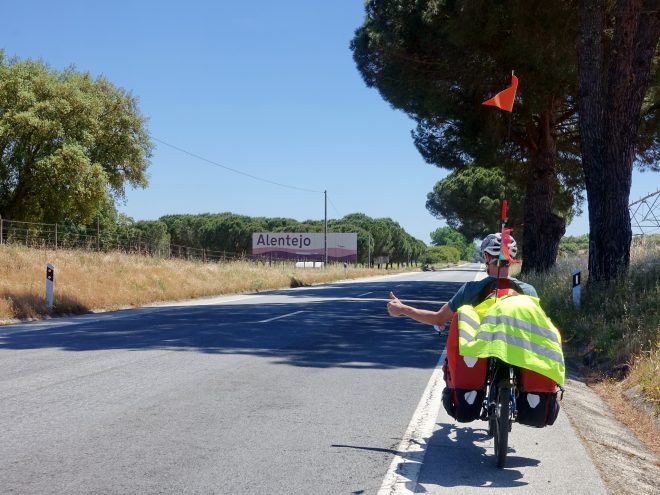 Some of our best cycling was in Alentejo. September was ideal for this, as the weather was sunny, the days still warm enough to go for swims, and the nights already nicely cool. We cycled down the Alentejo coast from the peninsula of Tróia, stopping at the beach in Santo André and then going through Sines, Vila Nova de Milfontes and Zambujeira do Mar. There are countless beaches of the best kind – sandy, wild, sometimes difficult to access, and not built up at all because it is a protected area. Add a few nice little towns to this, and you have your perfect cycle tour.
Some of our best cycling was in Alentejo. September was ideal for this, as the weather was sunny, the days still warm enough to go for swims, and the nights already nicely cool. We cycled down the Alentejo coast from the peninsula of Tróia, stopping at the beach in Santo André and then going through Sines, Vila Nova de Milfontes and Zambujeira do Mar. There are countless beaches of the best kind – sandy, wild, sometimes difficult to access, and not built up at all because it is a protected area. Add a few nice little towns to this, and you have your perfect cycle tour.
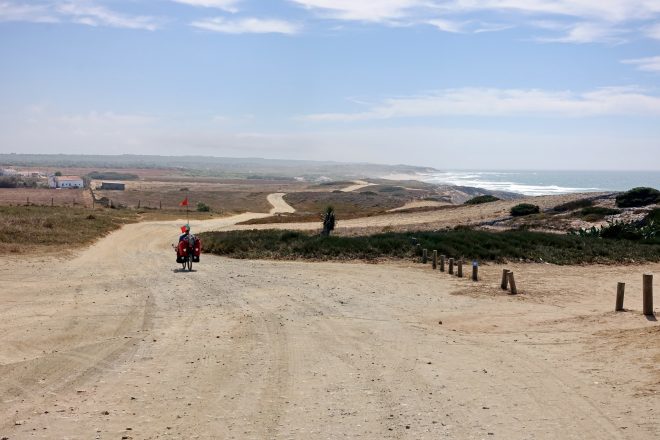
We tried to keep to smaller roads close to the sea, which was successful most of the times. Nevertheless, we had a couple of “interesting” experiences:
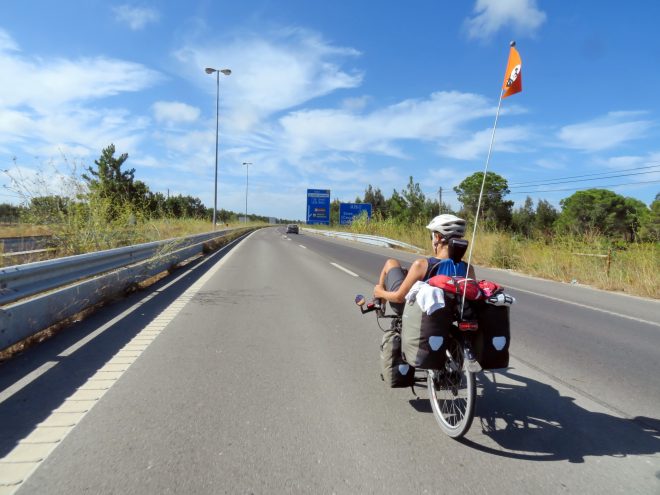 In Vila Nova de Santo André, our quiet country road suddenly became a highway! It was a bit confusing because it looked like a highway, but the left lane was closed, and the signs prohibiting pedestrians, cyclists and horses to enter was hidden with a black plastic sheet. We had been warned about this and knew that this was some kind of illegally built highway that wasn’t allowed to function as such. Thus, cyclists could use it – fortunately I’d say, as there is no parallel road at all. That’s how we ended up cycling on the left (closed) lane, a luxury cycle lane!
In Vila Nova de Santo André, our quiet country road suddenly became a highway! It was a bit confusing because it looked like a highway, but the left lane was closed, and the signs prohibiting pedestrians, cyclists and horses to enter was hidden with a black plastic sheet. We had been warned about this and knew that this was some kind of illegally built highway that wasn’t allowed to function as such. Thus, cyclists could use it – fortunately I’d say, as there is no parallel road at all. That’s how we ended up cycling on the left (closed) lane, a luxury cycle lane!
It was a bit scary at times, as we weren’t entirely sure if some car drivers would have the same idea and suddenly show up behind us. And once the initial thrill was over, it got very boring. We thus took one exit before Sines and took a small country road that lead us right to a cycle path going all around the town (Sines is a port town with a bit of a rough feeling to it – not really worth the visit unless you want to admire parts of the nice cycle path). Update: as of March 2017, the highway is officially only for cars most of the way. The way to go from V. N. Santo André to Sines by bicycle is to take the beginning of what looks like a highway until there is the sign “bicycles forbidden”, and the exit towards “Praia da Fonte do Cortiço”. You take that exit, cross over to the other side of the highway and there is a new parallel road going south. The Eurovelo 1 is not yet updated.
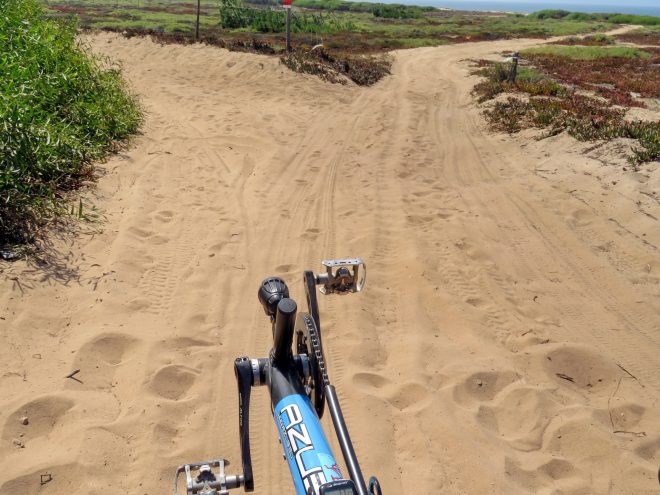 A bit further down, after Porto Covo, we made the mistake of following the arrows indicating Eurovelo 1. We ended up in the worst sand ever and had to push very hard to get ourselves out of there. We strongly advise to take the detour on asphalted roads, via Salgadinho to Ribeira da Azenha. It’s probably not as scenic and certainly farther away from the beaches, but the sandy paths are really not made for anything else than walking. We wrote to the European Cyclists Federation and they have corrected at least part of the path on the map to go on the road instead of sand tracks.
A bit further down, after Porto Covo, we made the mistake of following the arrows indicating Eurovelo 1. We ended up in the worst sand ever and had to push very hard to get ourselves out of there. We strongly advise to take the detour on asphalted roads, via Salgadinho to Ribeira da Azenha. It’s probably not as scenic and certainly farther away from the beaches, but the sandy paths are really not made for anything else than walking. We wrote to the European Cyclists Federation and they have corrected at least part of the path on the map to go on the road instead of sand tracks.
The interior of the Alentejo is also worth a visit. We followed the river Guadiana from the south coast, stopping in Mértola, Minas de São Domingos, Serpa, Viana do Alentejo, and Alcácer do Sal, before returning to Tróia. All these towns are absolutely worth a visit, and the roads in between lead through olive groves and vineyards.

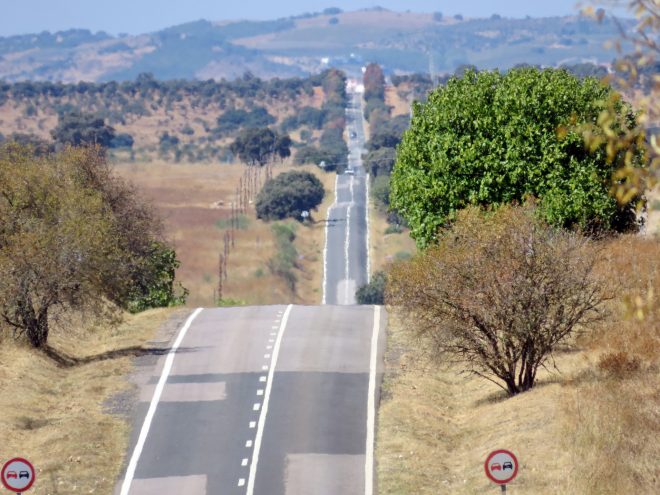
There are also a few dams with big artificial lakes in the region, which make good spots for wild camping and swimming (zoom in on the map and hover over the points to see where we camped).
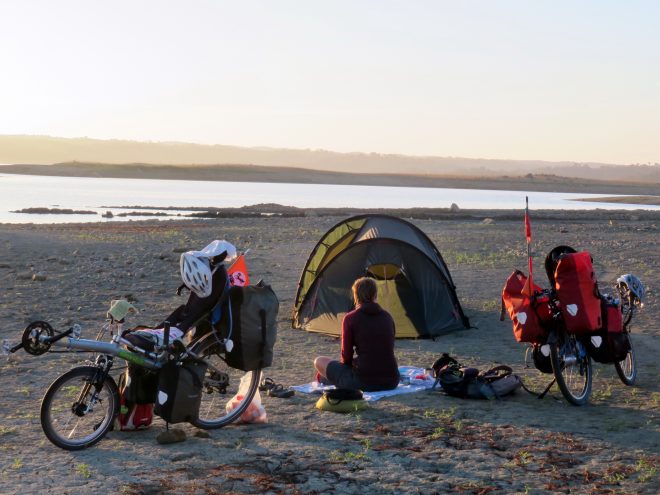
Serra da Estrela
If it’s a challenge you’re after, we can recommend the Serra da Estrela, and continental Portugal’s highest point, Torre. In our quest to join the sources of the two largest rivers in Portugal (the Mondego and the Zêzere), we pedalled from Seia to Vale do Rossim. This is a long and strenuous climb, but the road was quiet and the views rewarding.
The day after, we did the descent to Sabugueiro, followed by the ascent to Torre at almost 2000 metres altitude. The beginning of the climb was tough, with a 10% inclination almost all the time, but it flattened out after Lagoa Comprida, a dam and water reservoir and also a busy tourist spot.
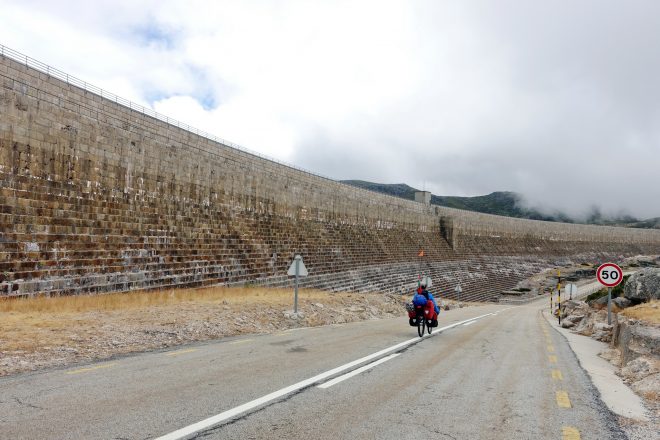
Luckily for us, the weather was overcast and foggy, and thus the road was not very busy even in August. When we approached the top, the clouds opened magically, offering us great views and making this ride very rewarding.
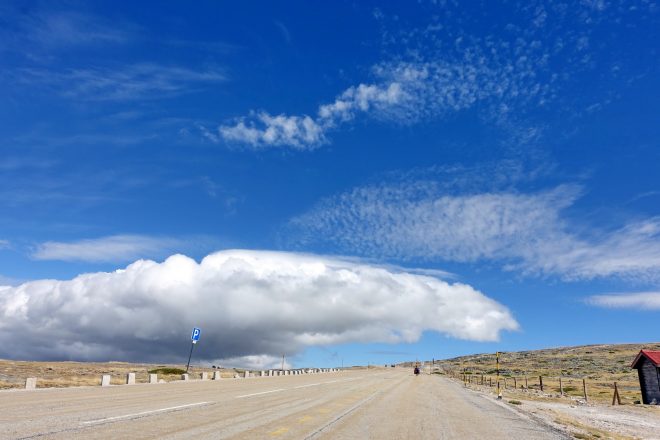
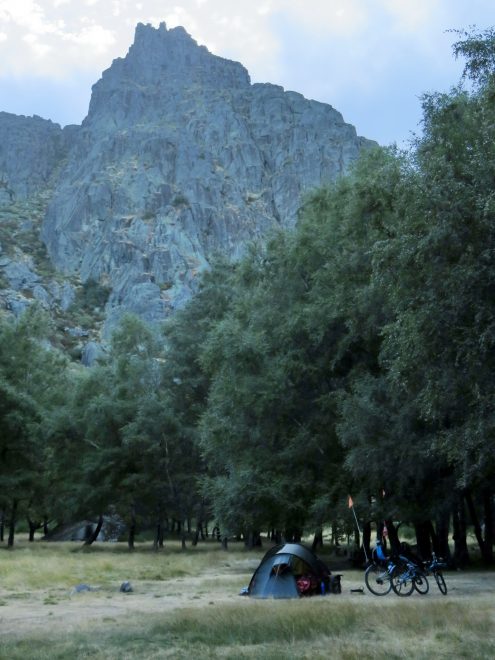
We finished the day by freewheeling down the hairpin bends to Covão da Ametade, an abandoned camp site where we spent the night (a little note if you’re going there: There was no water on the site except for a small source close to the abandoned toilet building. There are more reliable water sources up and down the road and we recommend filling up your bottles there).
Lisbon to Elvas
Our last stretch of cycling in Portugal was going from Lisbon to Elvas. If you search a bit online, you will come across information about the Ecovia 1 (Lisbon to Badajoz in Spain), for which you can download the GPS file. However, this is not an “official” cycle way and it’s not signposted. It’s mostly on dirt roads and tries to avoid main roads as much as possible. We ended up doing our own thing, combining parts of the Ecovia with the route suggested by cycle.travel. We ended up with a very enjoyable ride, through a very rural countryside. We we able to do some wild camping, crossed a few sleepy towns, and spent an afternoon in Elvas (which wasn’t enough to visit the town properly as we would have liked to, so we will be back!).
The drivers and the people
Portugal has the disadvantage of having a land border only with Spain, so if you’re cycling to Portugal from another country you will very probably have cycled through Spain. And after cycling in Spain, any country will seem worse in terms of drivers’ behaviour.
Comparisons aside, Portuguese drivers are a mixed bunch, but the general attitude still seems to be stuck in the “cycling is dangerous and you shouldn’t be on this road” kind of mood. Road cycling is not (yet?) very popular. For most people, “cycling” means putting your bike in (or on) your car on a Sunday, drive somewhere, park the car, and cycle a few kilometres on a bike path and back.
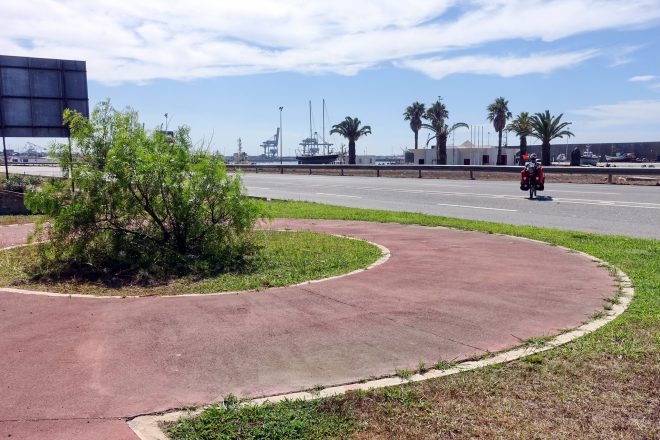
All this may explain that many drivers in Portugal do not behave as we wished they would towards cyclists. Dangerous overtaking manoeuvres are particularly common – passing too close and without visibility. Some roads are outright dangerous, such as very straight roads, where drivers tend to speed, or roads that get a lot of truck and agricultural traffic.
At the same time, it’s not all black and things seem to be evolving. There is a (hopefully growing) part of drivers who will slow down behind you, overtake with plenty of space and give you a friendly wave. If you want to have a good time cycling in Portugal, you have to do a bit of planning to get on the right roads. Many country roads are very quiet and absolutely perfect for cycle touring. Roads that run more or less parallel to a highway are also a very good bet (such as this one). Be aware that some roads might suddenly become bigger and transform into highways that are prohibited for cyclists. To avoid this, we used an online route planning tool (cycle.travel), which would always make us avoid these roads.
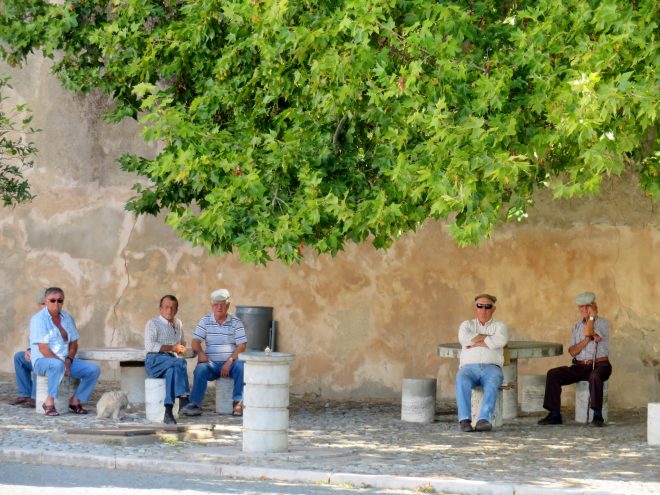
As a people, the Portuguese are very friendly. Compared to their neighbours, they are rather quiet and a bit reserved, which we found very enjoyable. They might not come and talk spontaneously to a bicycle traveller (especially a non-Portuguese-looking one), but once you make the first step they will happily give you directions, indicate a good place to eat, or just chat for a while. Speaking a bit of Portuguese is definitely a plus, but you may be surprised at how many (mostly older) people speak French, understand Spanish and many younger people speak good English.
Basic necessities: Water, food, sleeping, and other useful stuff
Water
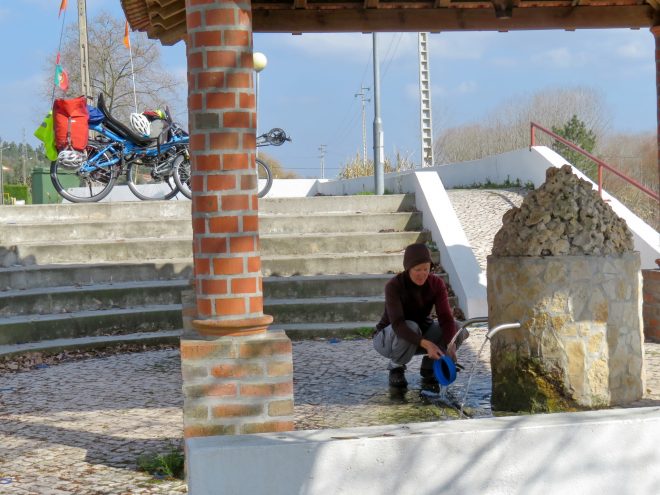 Tap water is always potable. Water supply on the road is easy, as almost every park, square or village has at least one water tap with drinking water. At the village café, they are happy to fill your water bottles, especially if you buy a coffee (which often costs as little as 60 cents). Spring water fountains are also common in the mountainous regions, where you will see people driving up in their car with many empty bottles to fill them with the excellent spring water.
Tap water is always potable. Water supply on the road is easy, as almost every park, square or village has at least one water tap with drinking water. At the village café, they are happy to fill your water bottles, especially if you buy a coffee (which often costs as little as 60 cents). Spring water fountains are also common in the mountainous regions, where you will see people driving up in their car with many empty bottles to fill them with the excellent spring water.
Don’t forget that water is not only for drinking – it’s also for swimming in! Apart from the uncountable beaches on the Atlantic coast, Portugal has many rivers that are nice for a refreshing swim. Villages along rivers often have a praia fluvial or river beach, perfect for a break, a picnic and a swim, especially in the hot summer.
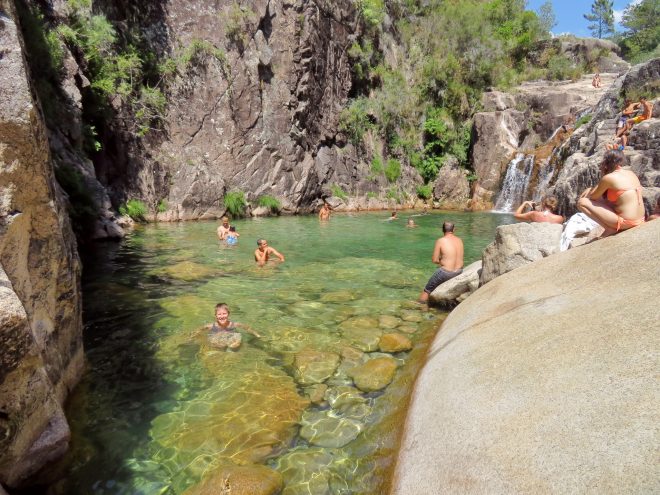
Food
Portugal is a food paradise for cyclists (at least for omnivores, the diet is heavily based on meat and fish). Almost every village has at least a café that will serve basic food or prepare a fresh sandwich for lunch. Simple restaurants are also common, and away from the tourist regions you can find a lunchtime menu for as little as 5 or 6 Euros, including drinks. Evening meals are also relatively inexpensive compared to most western European countries, with servings usually big enough to share. When we cycled in the summer and mostly slept at campsites, we almost never used our stove!
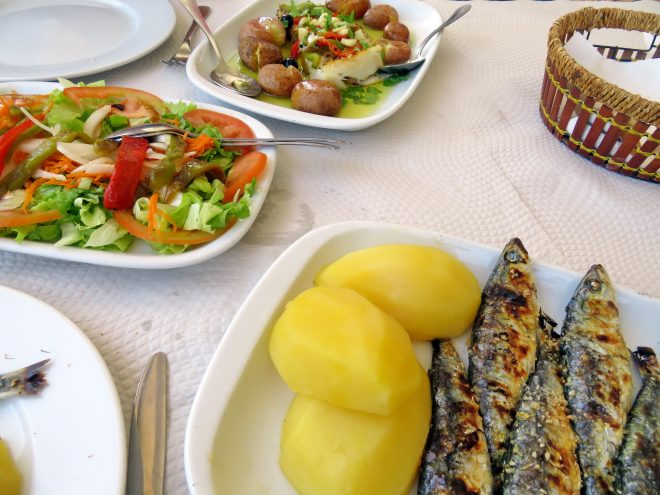
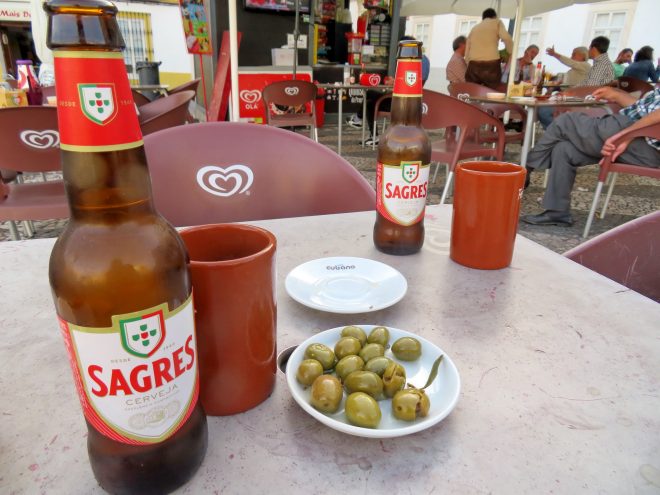
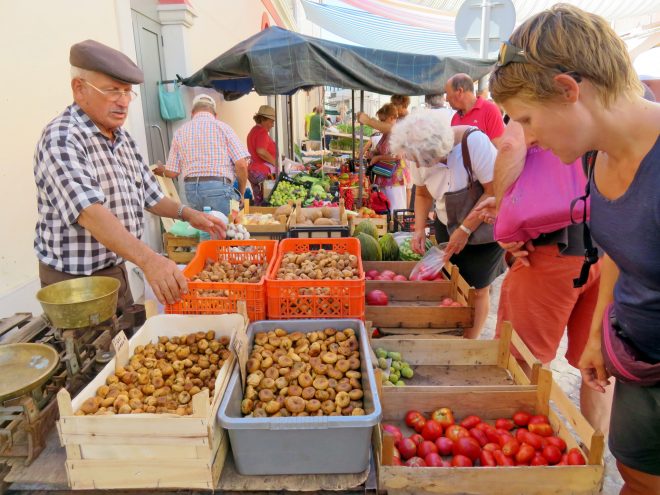
Small grocery shops can also be found in most villages, and small towns usually have a supermarket where cyclists can get plenty of supplies. Depending on the season you might be able to pick figs or pomegranates directly from the trees growing by the roadside, or you might see orange trees full of fruit everywhere, and very good oranges being sold by the kilo for almost nothing. Markets are very common everywhere in Portugal and are the best place to get fruit, vegetables and local produce. Bakeries and pastry shops (pastelarias) are also everywhere and shouldn’t be missed.
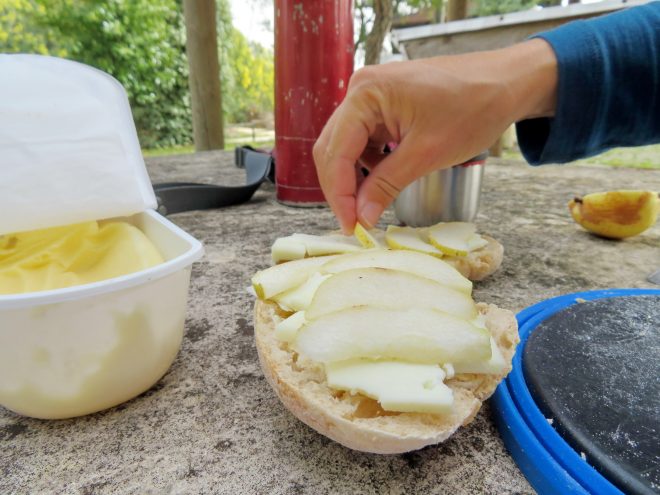
Sleeping
There’s ample choice of overnight options in Portugal at very good prices. Campsites are all over the place and almost always of good quality, although some can be a bit noisy in the summer months. Guesthouses and hotels are also common, and we have been able to find deals such as a good quality airconditioned room with private bathroom and breakfast buffet for under 40 Euros a night, during the summer season. And if you feel the need to splurge on a nice hotel room with a pool for one night, it won’t make you poor either. Just keep an eye out for online deals.
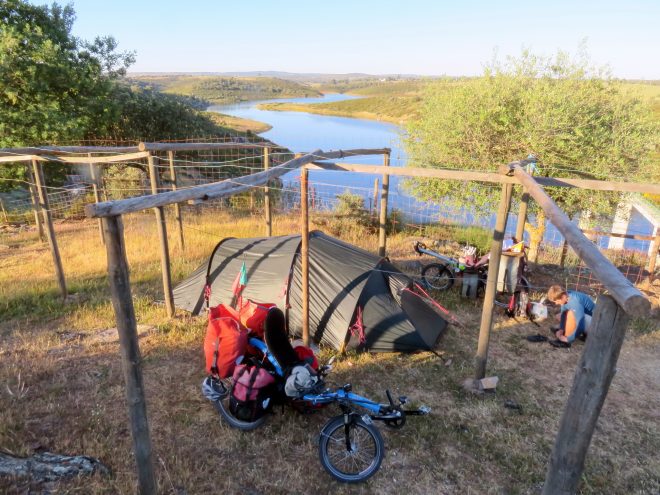
We camped wild a few times and found it surprisingly easy. Lakes, dams and water reservoirs are good places because you can access the water most of the time (good for a swim and a wash), and it seems quite common for people to spend the night there to go fishing very early in the morning (so, don’t expect to be alone). Once, we found a perfect-looking spot close to a village, and as there was a flock of sheep close by we went to ask the shepherd if we could camp there. It was not a problem for him, and he even showed up in the morning to make sure we had spent a good night.
Other useful stuff
For those of you cooking with fuel, white gas is easy to get in hardware stores, such as AKI (it’s called benzina). Otherwise, gas cylinders are easiest found at Decathlon (most bigger towns have one). Please, be extremely cautious with fire (even small fires such a hobo stoves), for the reasons explained below.
Dangers
The only obvious danger we encountered in Portugal were car drivers (see above). At our knowledge, there are no dangerous animals around. There are many, many dogs, and they bark a lot, but the vast majority of them are kept attached or confined in a garden or yard, and very few are stray.
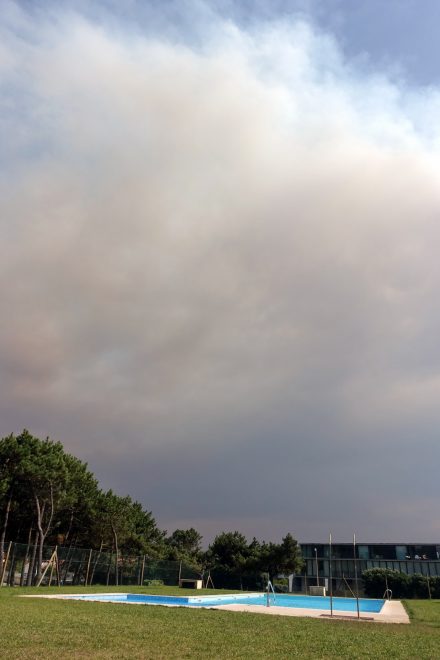
One danger that cyclists should be aware of in the warmer months are forest fires. Every summer, there are numerous bigger and smaller forest fires, most of them are rapidly controlled by the firefighters, but some can spread very fast and become a deadly trap (such as this one in June 2017). To avoid getting trapped, check the news regularly and/or ask the locals about fires in the region where you’re cycling – some roads might be closed off. Also, personally we would be very, very cautious with wild camping in Portugal in the summer, especially around forests.
Orientation
We used our usual strategy of a paper map (the ACP road map) for general route planning, then refining the route on cycle.travel and transferring the GPX file to our smartphones for day-to-day navigation on the OsmAnd App. Information on Open Street Maps was mostly accurate even in remote regions, although there were sometimes not many points of interest marked.
Weather
Portugal has a lot of Atlantic coast line, and the weather is mostly temperate there. Even in August it wasn’t too hot to cycle by the coast, and there was often a refreshing breeze. More inland, summers get hotter though, and we did have some really hot days in August when we followed the Zêzere river down to Lisbon.
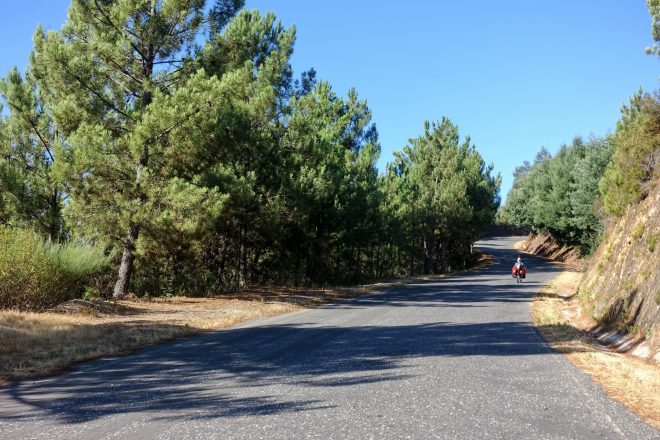
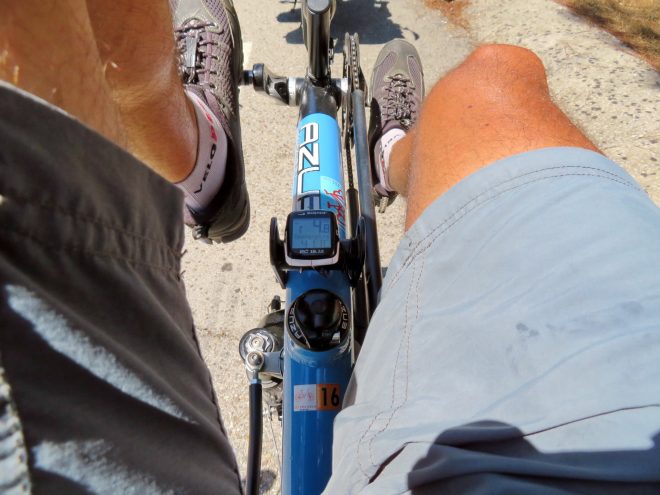
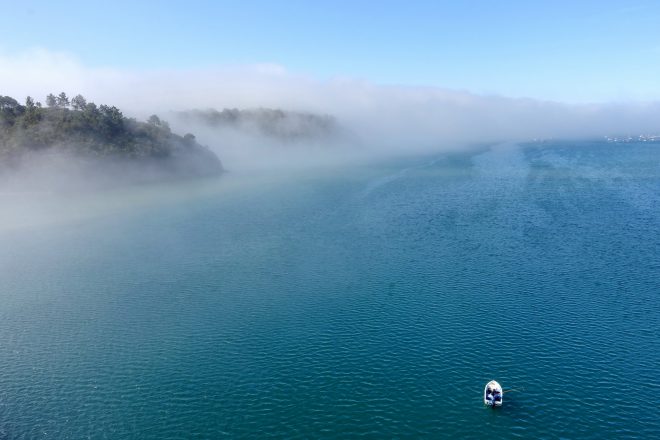 September was a very nice month to cycle around the South (Alentejo and Algarve). It was sunny almost all the time, still warm (even hot sometimes), perfect to swim in the sea, but the nights were already cooler. By the coast, we also had some morning fog announcing early autumn.
September was a very nice month to cycle around the South (Alentejo and Algarve). It was sunny almost all the time, still warm (even hot sometimes), perfect to swim in the sea, but the nights were already cooler. By the coast, we also had some morning fog announcing early autumn.
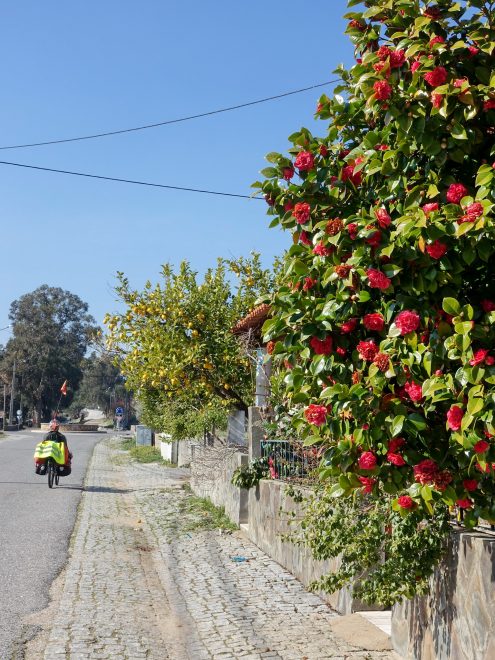
Winter can also be a nice time for cycling in Portugal, if you don’t mind the occasional rain shower and the short days. We crossed Portugal in February, coming from Madrid, and had some very nice early spring days with temperatures around 20°C, sun, lots of spring flowers and citrus trees full of fruit.
So, how was it?
Great. Perfect. An absolute favourite. No need to say more!
We will be back with our bikes, for sure.
And you should go, too!
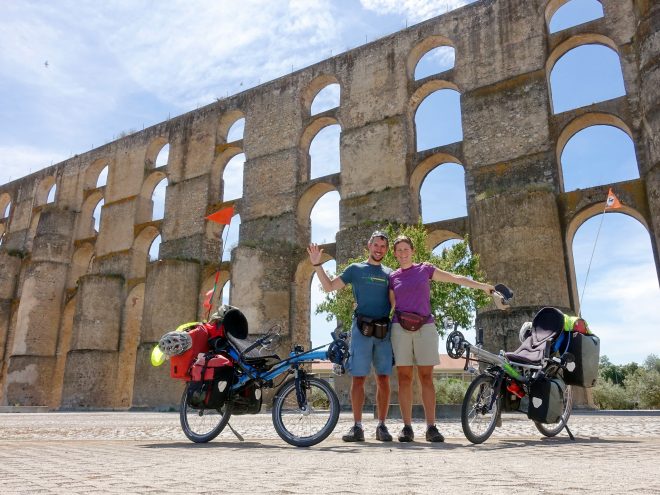
If you want to read more about cycling in Portugal:
- Our journey from the Northern coast to the highest point of Portugal, following river Mondego (in French)
- Our journey from Serra da Estrela to Lisbon, following river Zêzere (in French)
- Our journey from Lisbon to Algarve along the coast of Alentejo (in French)
- Our journey from Algarve to Lisbon, in the interior of Alentejo (in French)
- Our journey from Madrid to Lisbon in Winter (in French)
- Photos of a day on the beach not far from Lisbon
- How to get in and out of Lisbon by bicycle






















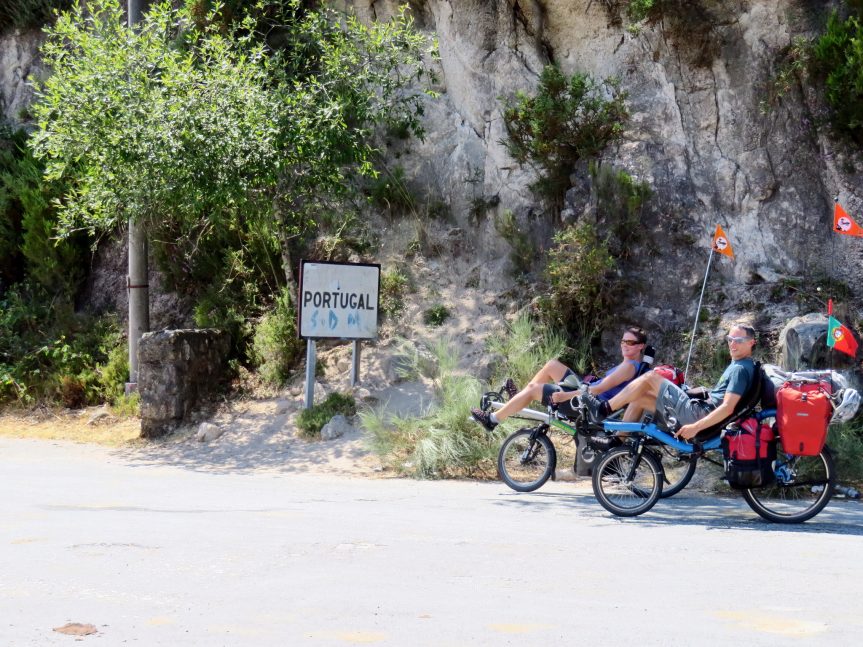
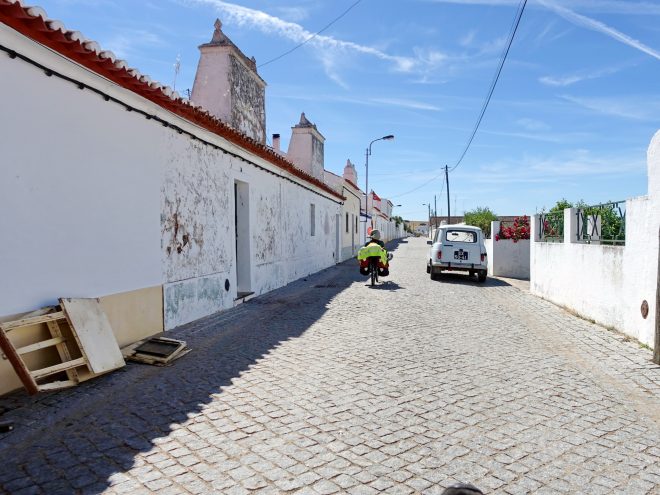
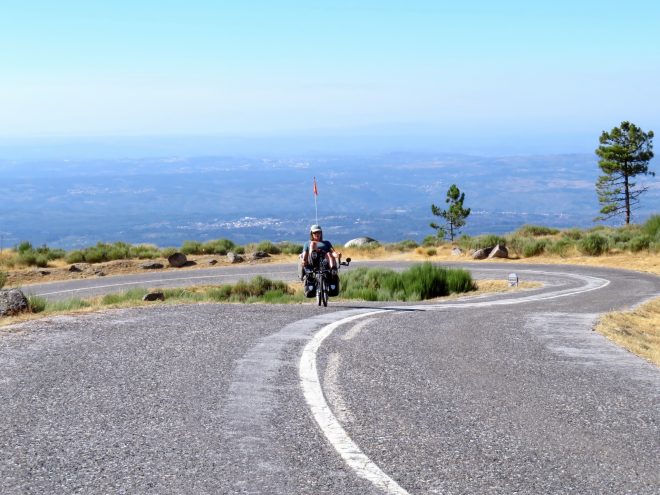
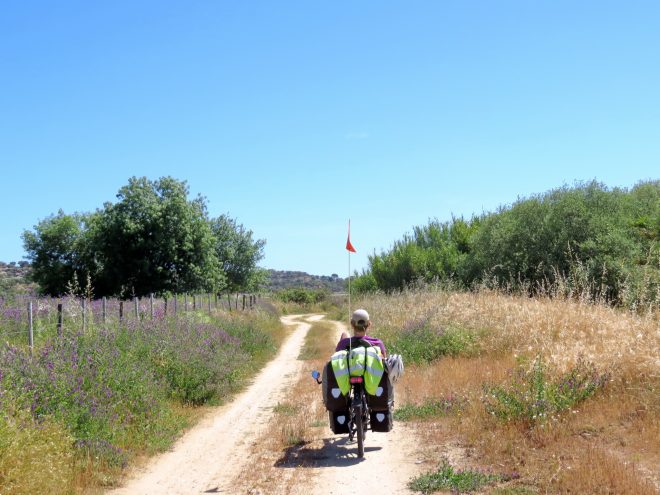
Thanks for the beautiful post! Portugal is definitely on my list of places to visit, and it seems worthwhile to go cycling there!
Thanks for this excellent piece. I’m planning to retire soon in Portugal but am debating whether I should take my recumbent tricycle. I visited in June and saw much of the country but was a bit daunted by the lack of bike lanes wide enough to accommodate the trike. Are you aware of other web pages that address riding tricycles in Portugal?
Thanks again
Dan Shaw
Hi Dan, it is not yet very common to see trikes in Portugal, as well as there are not so many bike lanes when doing long tours (except on the coast line). Saying that, I believe that being a different vehicle, car drivers pay attention and are more careful. Few people like https://www.ovarcraft.com/products.htm or “José Luis Magalhaes” in Facebook ride trikes in Portugal.